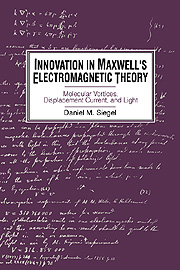Book contents
- Frontmatter
- Contents
- Preface
- Introduction
- 1 The background to Maxwell's electromagnetic theory
- 2 Mechanical image and reality in Maxwell's electromagnetic theory
- 3 The elaboration of the molecular-vortex model
- 4 The introduction of the displacement current
- 5 The origin of the electromagnetic theory of light
- 6 Beyond molecular vortices
- Conclusion
- Appendix 1 Draft of “On Physical Lines of Force,” a fragment
- Appendix 2 Drafts of “A Dynamical Theory of the Electromagnetic Field”
- Appendix 3 Vortex rotations in a curl-free region
- Notes
- Index
1 - The background to Maxwell's electromagnetic theory
Published online by Cambridge University Press: 24 October 2009
- Frontmatter
- Contents
- Preface
- Introduction
- 1 The background to Maxwell's electromagnetic theory
- 2 Mechanical image and reality in Maxwell's electromagnetic theory
- 3 The elaboration of the molecular-vortex model
- 4 The introduction of the displacement current
- 5 The origin of the electromagnetic theory of light
- 6 Beyond molecular vortices
- Conclusion
- Appendix 1 Draft of “On Physical Lines of Force,” a fragment
- Appendix 2 Drafts of “A Dynamical Theory of the Electromagnetic Field”
- Appendix 3 Vortex rotations in a curl-free region
- Notes
- Index
Summary
The first half of the nineteenth century was marked by the discovery of a variety of new phenomena in electricity and magnetism, and the general task to which Maxwell then addressed himself, beginning in the 1850s, was the development of a unified electromagnetic theory that would incorporate all of these phenomena. Section 1 of this chapter explores the broad background in nineteenth-century electromagnetic experiment and theory for Maxwell's work. Section 2 deals with the particular scientific and mathematical education and training that Maxwell brought to his work in electromagnetic theory, including his educational experiences at the universities of Edinburgh and Cambridge, as well as the epistolary tutelage of William Thomson. Finally, Section 3 deals with the methodological approach – growing out of the combined Scottish and Cambridge backgrounds – that Maxwell brought to his work.
Electricity and magnetism from Oersted to the 1840s
The discovery of the magnetic effects of electric currents, announced by Hans Christian Oersted in July 1820, defined the agenda for the study of electricity and magnetism during the following decades. Viewed in broad terms, Oersted's discovery had implications in two directions: First, Oersted's research had been undertaken in the context of widespread preoccupation – following Alessandro Volta's invention of the voltaic pile in 1800 – with the connections between electric currents and other physical phenomena, including chemical effects, heat, and light.
- Type
- Chapter
- Information
- Innovation in Maxwell's Electromagnetic TheoryMolecular Vortices, Displacement Current, and Light, pp. 5 - 28Publisher: Cambridge University PressPrint publication year: 1992



